October 2, 2014 weblog
Researcher propose new theory to describe how saber-toothed cats downed their prey

(Phys.org) —Independent researcher and pathologist Jeffrey G. Brown has self-published a paper on the open access site PLoS ONE, detailing what he believes is the correct interpretation of how the now extinct saber-toothed cat brought down its prey. He suggests prevailing views on the process wouldn't work and proposes a new idea that is based on the same mechanism as an ordinary manual can opener.
Saber-toothed cats have sparked the imagination of generations of children and adults alike, with their very long canines, the animals continue to strike fear in people to this day, despite the creatures being extinct for approximately 10,000 years. Over the years, scientists have offered various ideas to describe just how exactly the cats used their long teeth to bring down prey. Initial theories suggested they simply jumped on the backs of other animals and slashed at them with their teeth (hence the name saber) till the unfortunate victim died. A closer look revealed that such an approach was highly unlikely due to the toughness of the hide sported by most prey of the time, and the degree of muscle in the cats' neck.
More recently paleontologists came up with a theory called the "canine shear bite" which proposes that the cats jumped on the backs of victims first puncturing the skin with its lower jaw and then leveraging the neck to allow for slicing down into the victim with the long teeth. Brown claims this method wouldn't work either because it wouldn't generate enough force. He proposes that the cat's first dug in just slightly with the lower jaw, for use as a lug, like a can-opener, then pushed mightily against the ground with their forelimbs. Such an approach, which Brown calls a "Class 1 Lever Model" would allow the cat to use the muscles in its legs, back, neck and jaws to bring down prey, providing much more leverage and force.
Brown suggests further research, such as computer simulations would prove his idea correct, and furthermore, would likely explain the hunting techniques of most if not all of the "saber" beasts that once roamed the Earth killing with their massive teeth.
More information: Brown JG (2014) Jaw Function in Smilodon fatalis: A Reevaluation of the Canine Shear-Bite and a Proposal for a New Forelimb-Powered Class 1 Lever Model. PLoS ONE 9(10): e107456. DOI: 10.1371/journal.pone.0107456
Abstract
The jaw function of Smilodon fatalis has long been a source of debate. Although modern-day lions subdue large prey through the use of a suffocating throat bite, the dramatically elongated maxillary canines of S. fatalis suggest an alternative bite mechanism. The current literature favors a "canine shear-bite," in which the depression of the cranium by the ventral neck flexors assists the mandibular adductors in closing the jaws. Although the model makes intuitive sense and appears to be supported by scientific data, the mechanical feasibility of "neck-powered" biting has not been experimentally demonstrated. In the present study, the computer-assisted manipulation of digitized images of a high-quality replica of an S. fatalis neck and skull shows that a rotation of the cranium by the ventral neck flexors will not result in jaw closure. Instead, the cranium and mandible rotate ventrally together (at the atlantooccipital joint), and the jaws remain in an open configuration. The only manner by which rotation of the cranium can simultaneously result in jaw closure is by an anterior rotation at the temporomandibular joint. Based on this finding, the author proposes a new Class 1 lever mechanism for S. fatalis jaw function. In this model, the mandible is immobilized against the neck of the prey and a dorsally directed force from the extension of the forelimbs rotates the cranium anteriorly at the temporomandibular joint. The maxillary canines pierce the prey's neck and assist in clamping the ventral neck structures. The model is based on a maximum gape angle of approximately 90° and incorporates a secondary virtual point of rotation located slightly anteroventral to the temporomandibular joint. The Class 1 Lever Model is mechanically feasible, consistent with current data on S. fatalis anatomy and ecology, and may provide a basis for similar studies on other fossil taxa.
Journal information: PLoS ONE
© 2014 Phys.org




















